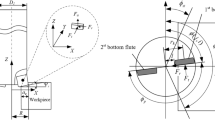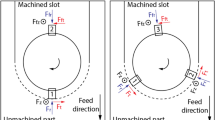Abstract
Based on the spectrum analysis of the cutting forces, a simple and practical method to determine phase shift between the angular position of measured cutting forces and coordinate origin of the force model is presented. Comparing with the traditional method, the proposed method of determining phase shift does not need to select a specific reference point on the measured cutting force profiles, nor does it need to restrict the cutting conditions to single tooth engaging. Once the phase shift is determined, FFT (fast Fourier transform) is used to decompose the measured cutting force into the nominal cutting forces and the disturbing forces caused by the cutter runout geometry. Dual-mechanism global cutting constants can be extracted from the nominal cutting forces in one cutting test. By using the extracted cutting constants, online cutter runout can be identified from the disturbing force components at spindle frequency. To validate the proposed method, numerical simulations and milling experiments are carried out in this paper.







Similar content being viewed by others
Data availability
Applicable.
Code availability
Software application.
Abbreviations
- A, A o :
-
Vectors of the Fourier series coefficients for the nominal milling force and cutter runout related force
- α, N, R:
-
Helix angle, number of cutter flutes and cutter radius
- β p :
-
Flute angular spacing
- d a :
-
Axial depth of cut
- DGCC:
-
Dual-mechanism global cutting constants
- Δϕ :
-
Phase shift between the starting angle position of force measurement and the origin of force model coordinate
- ϕ :
-
Cutter angular displacement
- ICFC:
-
Instant cutting force coefficients
- k t, k r :
-
Cutting constants of LGCC in the tangential and radial directions
- k ts, k rs :
-
Shearing force constants of DGCC in the tangential and radial directions
- k tp, k rp :
-
Plowing force constants of DGCC in the tangential and radial directions
- LGCC:
-
Lumped global cutting constants
- LVCC:
-
Lumped variable cutting coefficients
- λ:
-
Angular location of the cutter runout
- θ :
-
Angular position of cutting edge at the workpiece
- θ 1 , θ 2 :
-
Cutting angles of entry and exit
- t x :
-
Feed per tooth
References
Koenigsberger F, Sabberwal AJP (1961) An investigation into the cutting force pulsations during milling operations. Int J Mach Tool Design Res 1:15–33
Tlusty J, MacNeil P (1975) Dynamics of cutting forces in end milling. Annals of the CIRP 24:21–25
Wang JJ, Zheng CM (2002) An analytical force model with shearing and ploughing mechanisms for end milling. Int J Mach Tool Manu 42:761–771
Kline WA, DeVor RE, Lindberg JR (1982) The prediction of cutting forces in end milling with application to cornering cuts. Int J Mach Tool Design Res 22:7–22
Li G, Li S, Zhu K (2020) Micro-milling force modeling with tool wear and runout effect by spatial analytic geometry. Int J Adv Manuf Technol 107:631–643
Wojciechowski S, Matuszak M, Powałka B, Madajewski M, Maruda RW, Krolczyk GM (2019) Prediction of cutting forces during micro end milling considering chip thickness accumulation. Int J Mach Tool Manu 147:103466
Jing X, Lv R, Chen Y, Tian Y, Li H (2020) Modelling and experimental analysis of the effects of run out, minimum chip thickness and elastic recovery on the cutting force in micro-end-milling. Int J Mech Sci 176:105540
Zhai Y, Gao H, Wang Y (2019) Influence of cutting parameters on force coefficients and stability in plunge milling. Int J Adv Manuf Technol 104:2513–2523
Gao H, Shen H, Liu X, Li R (2020) Mechanics and dynamics research considering the tool radial runout effect in plunge milling. Int J Adv Manuf Technol 106:2391–2402
Chen D, Zhang X, Xie Y, Ding H (2018) Precise estimation of cutting force coefficients and cutter runout in milling using differential evolution algorithm. Annals of the CIRP 77:283–286
Wan M, Zhang WH, Tan G, Qin GH (2007) An in-depth analysis of the synchronization between the measured and predicted cutting forces for developing instantaneous milling force model. Int J Mach Tools Manuf 47:2018–2030
Hao H, Tang W, Wang B (2014) Two-step identification of instantaneous cutting force coefficients and cutter runout. Adv Mater Res 887:8881179–8881183
Wang JJ, Liang SY, Book WJ (1994) Convolution analysis of milling force pulsation. ASME Journal of Engineering for Industry 116:17–25
Kline WA, DeVor RE (1983) The effect of runout on cutting geometry and forces in end milling. Int J Mach Tool Design Res 23:123–140
Liang SY, Wang JJ (1994) Milling force convolution modeling for identification of cutter axis offset. Int J Mach Tools Manuf 34:1177–1190
Wang J.J, Zheng CM (2003) Identification of cutter offset in end milling without a prior knowledge of cutting coefficients, Int J Mach Tools Manuf 43:687–697
Armarego EJA, Despande NP (1989) Computerized predictive cutting model for cutting forces in end-milling including eccentricity effects. Annals of the CIRP 38:45–49
Hekman KA, Liang SY (1997) In-process monitoring of end milling cutter runout. Mechatronics 7:1–10
Cheng PJ, Tsay JT, Lin SC (1997) A study on instantaneous cutting force coefficients in face milling. Int J Mach Tool Manu 37:1393–1408
Acknowledgements
The authors gratefully acknowledge the support from “Research Center for Intelligent Manufacturing Application” in Quanzhou Vocational and Technical University, China.
Author information
Authors and Affiliations
Contributions
The name and the contribution of each author are listed below.
Dr. Charles Ming Zheng: first author, interpreting data, drafting, performing the numerical simulation and milling experiments.
Dr. Yaw-Hong Kang: corresponding author, checking the proposed method, editing the manuscript.
Corresponding author
Ethics declarations
Ethical approval
Not applicable.
Consent to participate
Not applicable.
Consent to publish
Applicable.
Conflict of interest
The authors declare no competing interests.
Additional information
Publisher’s note
Springer Nature remains neutral with regard to jurisdictional claims in published maps and institutional affiliations.
Appendices
Appendix 1
(CPar, CPbr,CPcr,CPdr) and (CPai, CPbi,CPci,CPdi) are denoted as the real and imaginary parts of (CPa, CPb,CPc,CPd), and (CPa, CPb,CPc,CPd) can be expressed as
where
Appendix 2
According to the formulations presented in [16], the cutter runout geometry can be determined with
or
where ρ and λ are the magnitude and angular location of cutter runout respectively. Equations (27) and (28) are used for up milling, while Eqs. (29) and (30) are applied for down milling. Aox and Aoy are denoted as the Fourier coefficients of the measured milling force at the spindle frequency in the X and Y directions. P3(1) and P4(1) are expressed as.
Rights and permissions
About this article
Cite this article
Zheng, C.M., Kang, YH. Locating the angular position of measured milling forces to determine dual-mechanism global cutting constants. Int J Adv Manuf Technol 115, 1517–1528 (2021). https://doi.org/10.1007/s00170-021-07157-5
Received:
Accepted:
Published:
Issue Date:
DOI: https://doi.org/10.1007/s00170-021-07157-5




